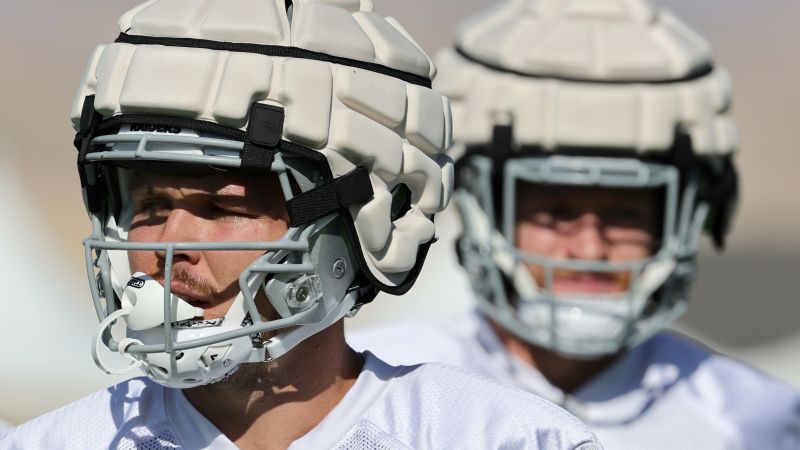Football’s Safety Under Scrutiny Amidst Rising Concerns Over Head Injuries
As football season approaches, the unmistakable sound of helmets colliding on the field serves as a poignant reminder of the physicality of the sport. However, this familiar noise is accompanied by a growing concern—scientific studies are increasingly suggesting that repeated impacts to the head, even without concussions, may lead to severe brain damage and a degenerative condition known as chronic traumatic encephalopathy (CTE).
Following a series of alarming incidents, including the tragic deaths of three young players within a month—two of whom suffered head injuries—coaches, trainers, parents, and football leagues are grappling with urgent questions regarding the safety of the game.
In response to the death of his 13-year-old son, Cohen Craddock, Ryan Craddock has advocated for the introduction of Guardian Caps, a soft-shell covering designed to be worn over existing helmets. “I believe if my son would have been wearing something like this, this would have made a totally different outcome,” he stated in an interview. “You’re not modifying the helmets. It’s just something that attaches directly on. So why not just have that extra layer of protection?”
While it seems intuitive to enhance padding around players’ heads, independent research on the efficacy of Guardian Caps in preventing head injuries remains scarce. Laboratory tests demonstrate that these caps can effectively lessen impact forces, yet studies involving college athletes have not yielded definitive evidence that the caps provide significant protection when compared to standard helmets.
Despite a push from the NFL, which now permits all players to use Guardian Caps during games and mandates their usage in practices, the controversy continues. Guardian Sports, the manufacturer, asserts that extensive testing and experiences from numerous collegiate teams suggest the caps reduce injuries. “We will tell anyone who asks that no product can make a player concussion proof,” said Erin Hanson, co-founder of Guardian Sports. “Our product… has over 12 years of on-the-field data and feedback… The NFL and CFL certainly wouldn’t mandate Caps if the data wasn’t clear.”
However, skepticism looms over claims of the caps’ efficacy. Dr. David Camarillo, a Stanford University bioengineering associate professor and former college football player, has expressed doubts about the clarity of available evidence. “I think the rationale is, football’s in big trouble. People are worried about CTE. We’re seeing kids dying,” he said.
According to Guardian’s claims, their XT model reportedly decreases impact to a player’s head by up to 33%, while the NFL model promises a reduction in head acceleration during collisions by up to 40%. NFL Vice President Jeff Miller addressed the caps’ effectiveness, noting a 50% decrease in concussions over the past two seasons for positions where usage was mandated. Despite these assertions, the NFL has yet to release supportive data, prompting calls for transparency among researchers such as Camarillo.
Miller assured that research backing these conclusions is forthcoming. “We actually have papers in progress that have been submitted to journals right now,” NFL Chief Medical Officer Dr. Allen Sills stated, adding that changes in cap design might have influenced previous study outcomes, as newer models have shown promising results in laboratory tests.
The National Athletic Trainers’ Association, however, cautioned against the expectation that aftermarket add-ons like Guardian Caps can effectively reduce injuries, stating, “The current evidence describes no benefit.” Independent studies, including one by Virginia Tech, have indicated minor benefits in laboratory settings but reported no significant reduction in impact forces among players on the field.
Recent research, including studies conducted by teams from the University of North Carolina and the University of Nevada, failed to establish a noticeable difference in head impact forces between those wearing Guardian Caps and those without. Similar findings emerged from a Stanford study that recorded measurable reductions in the lab but observed no significant differences during actual gameplay.
As discussion continues, experts emphasize that helmet selection remains paramount when considering player safety. “The most important factor is which helmet the player is in, not necessarily whether or not they’re wearing a cap,” stated Rowson. He recommended prioritizing high-quality helmets over secondary padding options.
Guardian Caps are priced at approximately $70 per unit, with NFL models retailing around $125. In light of limited funding, Murray suggests that investing in athletic trainers could yield better outcomes for player safety. “They save lives. They’re instrumental in the health and safety of the athletes,” he emphasized.
This ongoing dialogue surrounding helmet safety, the role of Guardian Caps, and the implications for player health and performance underscores the pressing need for continued research and oversight in the sport of football.
CNN’s David Close, Coy Wire, Holly Yan, Amanda Sealy, and Nadia Kounang contributed to this report.



